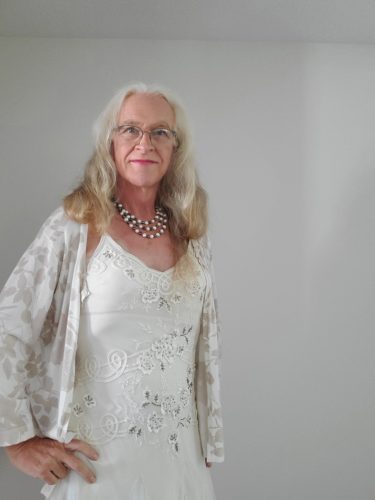The Transgender Voice and Communication Modification service at Mass Eye and Ear offers voice therapy to those who wish to explore and practice a voice that fits their personality and gender identity. Patient Polly Sioux shared her story.
Polly Sioux had never considered voice modification therapy. She first heard about it at the Transgender Health Program at Mass General Hospital, where she was then referred to the Voice and Speech Laboratory at Mass Eye and Ear. That’s where she met speech-language pathologists Elizabeth (Liz) Banaszak, MA, CCC-SLP and Abigail (Abby) Garneau, MA, CCC-SLP who started her on a personalized program that lasted 20 sessions and resulted in a voice that she felt was the right fit for her.
“It never occurred to me that my voice was something I could change,” Polly told Focus. “Liz and Abby helped me realize that I had a choice in my vocal register and resonance, and it really helped me.”

Personalized therapy approach
The Transgender Voice and Communication Modification service is comprised of speech-language pathologists, with specialized training in voice modification, and a board-certified otolaryngologist who specializes in surgery related to the voice and throat.
Through customized 45-minute therapy sessions, patients learn how to use their desired voice in a way that is healthy and comfortable.
The program starts with a “voice therapy menu,” which caters to each individual’s wants and needs. It focuses on matching a voice to a personality, not just gender identity. A common misconception is that pitch is the only important factor in changing the way your voice sounds. According to Liz, resonance is the most important, then layered on top is pitch, inflection, articulation, word choice, and non-verbal communication. Patients can also test out different non-verbal communication cues/body language. The voice modification program length varies and is typically eight to20 sessions, held once a week for about three to 12 months. Patients are discharged once they feel like they have found a voice that is sustainable and matches their gender identity and personality. Mass Eye and Ear offers both individual and group therapy options as part of the service.
“Group therapy is great because it is more cost effective, and the groups are small, only two to three people per group, so patients are still getting the one-on-one instruction while gaining confidence learning alongside their peers,” Liz told Focus. “Changing your voice can seem like an intimidating undertaking, and group sessions can ease nerves and foster a sense of community and camaraderie.”
Safe techniques critical for therapy’s success
The voice modification team emphasizes the importance of protecting yourself as you experiment with voice modification.
“We see patients researching on their own and finding recommendations for forcing the larynx to be lower,” Matthew Naunheim, MD, an otolaryngologist in the program, told Focus. “That can lead to strain and be risky.”
Dr. Naunheim encourages patients to safely experiment with voice exercises at home, but any discomfort or pain should be a red flag.
“If you begin to experience hoarseness, soreness or throat pain, these may be signs that you should be evaluated by a voice specialist,” he said.
The team also cautions against using online tutorials such as those on YouTube or other “home remedies” for voice therapy that involve manipulating the larynx, as some individuals may damage their larynx trying these methods at home without proper supervision.
[Listen to the video above to hear Polly at the start and end of her voice therapy sessions at Mass Eye and Ear.]
One patient’s journey to her voice
Polly Sioux, a patient in the program, said she was very skeptical at first, but that quickly changed after her first session.
“From the beginning, there was always a focus on building off my natural speaking voice, versus trying to create a completely new one,” she said. “I was asked to study voices I liked and talk with my therapists about how certain characteristics could fit into my program.”
Polly had four in-person visits before the pandemic hit, then her care program went virtual. She said virtual appointments have been tremendously helpful in saving time commuting from her home in central Massachusetts. Polly works as youth group leader and has shared her experience with the transgender community about the the program at Mass Eye and Ear.
“The people who work at Mass Eye and Ear are extremely patient and kind,” said Polly.
According to the Voice and Speech team, changing your voice requires daily commitment to home practice and regular attendance at therapy sessions. Home practice is an integral part of voice therapy because it takes several sessions to mentally focus on the way you are speaking while also thinking about the meaning of your message.
Polly is constantly working on her voice, often utilizing a phone app that measures pitch. She explained that when you begin voice therapy you have to train yourself to think about how you are using your voice all the time. After completing the program, she is now able to focus less on how she is speaking as it is becoming second nature to her.
“It’s a great feeling,” she said “It was crazy to go back and listen to old voice recordings of myself before voice therapy, I don’t recognize that voice!”
To learn more, please visit the Transgender Voice and Communication Modification service web page
Good day’s
Is there a hospital that treats my friend who has Retinitis Pigmentosa?
can you help me
Brgds/ Murat